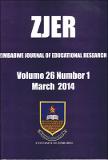| dc.contributor.author | Nhamburo, Vengai | |
| dc.contributor.author | Sithole, Mathias | |
| dc.contributor.author | Chinamasa, Emmanuel | |
| dc.coverage.spatial | Zimbabwe. | en |
| dc.date.accessioned | 2016-03-22T16:06:32Z | |
| dc.date.available | 2016-03-22T16:06:32Z | |
| dc.date.issued | 2014-03 | |
| dc.identifier.citation | Chinamasa, E., Nhamburo, V. and Sithole, M. (2014) Analysis of students' errors on linear programming at secondary school level: implications for instruction, Zimbabwe Journal of Educational Research, vol. 26, no.1, pp. 54-73. Harare: HRRC. | en |
| dc.identifier.issn | 1013-3445 | |
| dc.identifier.uri | https://opendocs.ids.ac.uk/opendocs/handle/20.500.12413/10232 | |
| dc.description | A research study to identify students' errors in linear programming. | en |
| dc.description.abstract | The purpose of this study was to identify secondary school students' errors on linear programming at 'O' level. It is based on the fact that students’ errors inform teaching hence an essential tool for any serious mathematics teacher who intends to improve mathematics teaching. The study was guided by a descriptive survey research design. Data was collected from a purposive sample of 91 mathematics teachers from Makoni and Marondera districts who responded to a questionnaire. This was complemented by an analysis of cluster samples of 162 students' answer scripts for Question 10, in Channon et al. (2004, p. 148), followed by the application of Newman's prompts for interviews. The study found that students were unable to deduce symbolic inequalities from word problems given and confused the use of inequality signs (> and > ) as a result of their inability to read and follow examples in their textbook. Students also had problems with graphing inequalities and only one student managed to deduce the profit function. The study noted that errors were arising from students' low proficiency in mathematical language as reflected by the highest errors at the reading level and wordy problems which students did not understand. Textbook examples were also structured for the bright student and teachers not properly sequencing their concepts. It was also noted that pupils with no graph papers had limited teachers' practice exercise assigned. The study recommends the following instructional strategies for teachers: structuring introductory exercises; teach students to read mathematics textbook examples and learn from them; and encourage students to read inequality statements as complete sentences. | en |
| dc.language.iso | en | en |
| dc.publisher | Human Resource Research Centre (HRRC), University of Zimbabwe (UZ) | en |
| dc.rights.uri | http://creativecommons.org/licenses/by-nc-nd/3.0/ | en |
| dc.subject | Education | en |
| dc.title | Analysis of students' errors on linear programming at secondary school level: implications for instruction | en |
| dc.type | Article | en |
| dc.rights.holder | University of Zimbabwe (UZ), Human Resources Research Centre (HRRC) | en |


